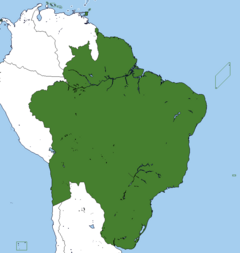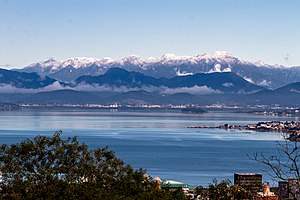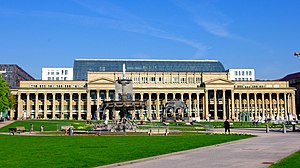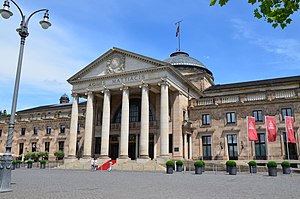Imperial Federation of Brazil: Difference between revisions
No edit summary |
m (The Inquisitor02 moved page Federal Republic of Brazil to Imperial Federation of Brazil: Retcon) |
(No difference)
| |
Revision as of 13:09, 9 December 2022
This article is incomplete because it is pending further input from participants, or it is a work-in-progress by one author. Please comment on this article's talk page to share your input, comments and questions. Note: To contribute to this article, you may need to seek help from the author(s) of this page. |
Federal Republic of Brazil República Federal do Brasil | |
|---|---|
| Motto: "Justiça, Igualdade, Perseverança" "Justice, Equality, Perseverance" | |
| Anthem: Brazilian National Anthem | |
 Brazil, 2007 | |
| Capital | Rio de Janeiro |
| Largest city | São Paulo |
| Official languages | Portuguese
Brazilian Sign Language (LIBRA) |
| Ethnic groups (2005) | 44.5% White 41.2% Mixed 8.2% Black 3.8% Asian 2.3% Amerindian |
| Religion (2005) | 56.7% Roman Catholic 14.5% Irreligious 7.9% Evangelical 6.3% Protestant 3.4% Spiritist 2.7% Other Christian 2.1% Afro-Brazilian Religions 6.4% Other Religions |
| Demonym(s) | Brazilian, Brazilese |
| Government | Federal parliamentary republic |
• Prime Minister | Giovanna Zanetti Gottschalk |
• President | Alessandro Padovan Malvezzi |
• President of the Supreme Federal Court | Sebastião Carvalho Arruda |
• Minister of Defense | Aloísio Ferreira Gomes |
| Legislature | Federal Parliament |
| Federal Senate | |
| Chamber of Deputies | |
| Independence from the Iberian Union | |
• Declared | 27 March 1787 |
• Recognized | 20 June 1798 |
• Slavery Abolished | 13 May 1871 |
| 9 July 1932 | |
• Current Constitution | 19 December 1935 |
| Area | |
• Metropolitan only | 10,963,827 km2 (4,233,157 sq mi) (2nd) |
| Population | |
• 2005 census | 242,003,000 |
• Density | 22.07/km2 (57.2/sq mi) |
| GDP (nominal) | 2006 estimate |
• Total | $7.36 trillion (3rd) |
• Per capita | $30,414 (28th) |
| Gini (2003) | 46 high (30th) |
| HDI (2006) | very high (39th) |
| Currency | Brazilian Real (R$) (BRL) |
| Time zone | UTC -5 to UTC -2 |
| Date format | dd-mm-yyyy (CE) |
| Driving side | right |
| Calling code | +55 |
| ISO 3166 code | BR |
| Internet TLD | .br |
Brazil (Portuguese: Brasil), officially the Federal Republic of Brazil (Portuguese: República Federal do Brasil), is the largest country in the continents of Latin America and South America. Brazil is the second-largest country by area and the sixth-most populous in the world. Its capital is Rio de Janeiro, which also briefly served as the capital of the Portuguese Empire during the Seven Years' War. The country is composed of a union of 41 states, two territories, and a Federal District. Brazil is the largest Portuguese-speaking country in the world. The country is the only Portuguese-speaking territory in the Americas, as well as the country with the largest Roman Catholic population. With access to both the Atlantic and the Pacific oceans, it borders all countries in South America without exceptions. Brazil covers more than half of the continent's area.
Brazil is one of the 17 megadiverse countries and is home to most of the Amazon Rainorest. The Amazon Rainforest is home to highly diverse wildlife and contains uncountable natural resources. These facts turned Brazil into a subject of global interest, especially due to environmental degradation processes such as deforestation. The government pursues an ambivalent policy towards the Forest. Although extensive areas of the Amazon are protected by indigenous federations and natural reserves, companies are given permission to exploit areas that contain mineral resources. The government forbade deforestation for agriculture. According to specialists, this is not out of preoccupation due to environmental degradation, but due to concerns regarding deindustrialization.
Brazil was inhabited by various tribal groups prior to the landing of Portuguese explorer Pedro Álvares Cabral in 1500, who then claimed the area for the Portuguese Empire. Brazil remained a Portuguese colony until 1808 when the capital of Portugal was transferred from Lisbon to Rio de Janeiro amidst the Napoleonic invasion of Portugal. In 1815 Brazil was elevated to the rank of kingdom following the formation of the United Kingdom of Portugal, Brazil, and the Algarves. Brazil achieved its independence in 1822 following its demotion back to the status of colony. The country was a unitary constitutional monarchy from 1822 to 1889, when a military coup deposed emperor Dom Pedro II and established an oligarchic federal presidential republic, led by the military. However, the Navy, opposed to the dictatorship, rebelled at the same time a revolution took place in the state of Rio Grande de São Pedro, in the far south of Brazil. The navy joined the southern rebels in a movement that became known as the Federalist Revolution, leading to the eventual deposition of the military dictatorship and the establishment of a democratic federal parliamentary republic in 1900.
Etymology
Brazil comes from the Portuguese word for brazilwood, pau-brasil; brasil means "red like an ember" in Portuguese.
The standard way to refer to a citizen of Brazil is as a "Brazilian". More recently, under the 1990 Orthographic Reform, Brazilese also has been accepted as an alternative to Brazilian and is often used in a political context.
History
Around the time of the Portuguese arrival, the territory of current day Brazil had an estimated indigenous population of 7 million people, mostly semi-nomadic tribes, who subsisted on hunting, fishing, gathering, and migrant agriculture. The Amerindian population comprised several groups, such as the Tupis, the Guaranis, and the Gês. Before European arrival, boundaries between these groups were marked by wars that came from cultural, moral, and linguistic differences. These wars involved cannibalistic rituals on prisoners of war.
Brazil was claimed for the Portuguese Empire on 22 April 1500, with the arrival of a fleet led by Pedro Álvares Cabral. The Portuguese encountered indigenous people divided into many groups, but most of them spoke the languages of the Tupi-Guarani family. The first Portuguese settlement was founded in 1532, and colonization effectively began in 1534 when King John III of Portugal divided Brazil into fifteen private and autonomous captaincy colonies. However, the decentralized and unorganized administration of the colonies proved to be unsustainable, and in 1549 the Portuguese king restructured them into the Governorate General of Brazil. The Governorate's capital, Salvador, housed the government of a single and centralized Portuguese colony in South America.
In the first two centuries of colonization, indigenous peoples and European settlers lived in constant warfare, creating opportunistic alliances in order to gain advantages against each other. Cane sugar was Brazil's main export, and slaves purchased in Sub-Saharan Africa were the main Brazilian import. Brazil received almost three million slaves from Africa between 1500 and 1800. By the end of the 17th century, sugar exports began to decline, and the Bandeirantes, a group of slavers and adventurers of mixed indigenous and Portuguese origin, discovered gold in 1690, marking the beginning of the Brazilian Gold Rush. The Gold Rush attracted many new settlers, and this period of increased immigration caused conflicts between newcomers and old settlers. The Bandeirantes also expanded the Brazilian borders during the 17th century. In the same period, other European powers tried to colonize Brazil, such as the French in Maranhão and the Dutch in Pernambuco, although these attempts failed and never were tried again.
In 1807, the Napoleonic Empire invaded Portugal, causing Prince Regent João, in the name of Queen Maria I, to move the royal court from Lisbon to Rio de Janeiro, the latter city being the capital of Brazil. Once arriving in the colony, they established Brazil's first financial institutions, such as local stock exchanges and its National Bank. They also ended the Portuguese monopoly on Brazilian trade and opened Brazil to other nations. In 1809, in retaliation for being forced into exile, the Prince Regent ordered the Portuguese conquest of French Guiana, which was formally annexed into Brazil following the Congress of Vienna of 1815.
In 1814, after the end of the Peninsular War, the European courts demanded the return of the Portuguese court to Lisbon. In 1815, as a justification to continue living in Brazil, the Crown created the United Kingdom of Portugal, Brazil, and the Algarves, thus establishing a pluricontinental transatlantic monarchic state. In 1821, acceding to the demands of revolutionaries, who were threatening independence from Brazil, Dom João VI left for Lisbon, leaving his son Prince Pedro de Alcântara as Regent of the Kingdom of Brazil.
Independence and the Age of Crises (1822-1840)
In 1822 the Portuguese Cortes attempted to demote Brazil back to its old status of colony. The Brazilians refused to yield, and Prince Pedro supported the Brazilians, declaring independence from Portugal on 7 September 1822. The Brazilian War of Independence was fought from 1822 to 1824, as the Portuguese garrisons in Brazil refused to recognize independence. Brazilian independence was recognized by Portugal on 29 August 1825, after Brazil paid a sum of money to Portugal as reparation for the loss of the colony. The sum paid to Portugal was the first international debt of Brazil, and it affected the economy for the following decades.
The first years after independence were troublesome. Republican sentiment in the northeast of Brazil was fairly strong. Some northeastern provinces felt left behind with the promulgation of the 1824 Constitution, which was considered to be too authoritarian and centralist. In July 1824 the Confederation of the Equador declared independence from Brazil, but the movement was quickly and brutally repressed by the authorities. The Confederation of the Equador is seen as a continuation of the Pernambucano Revolution of 1817, which attempted to declare Brazilian independence from Portugal and establish a liberal republic in Brazil.
Although the Argentine Confederation was among the first countries to recognize Brazilian independence, doing so before the United States, the Argentines had a keen interest in the region of Cisplatina (Uruguay), which was invaded by Portugal during the Napoleonic Wars as a way to solidify its rule in Southern Brazil. In 1825, shortly after the recognition of Brazilian independence by Portugal, the Uruguayan caudillo Juan Antonio Lavalleja gathered support from Argentine leaders and declared independence from Brazil on 25 August 1825. On 25 October the Argentine Congress declared the annexation of Uruguay, prompting the Brazilians to declare war on 10 December 1825. The war lasted until 1829, with the Great Fire of Buenos Aires. Despite initial defeats, the Brazilians managed to defeat the Argentine navy and blockade the La Plata River, in turn allowing Brazil to defeat the Argentines and sack Buenos Aires in 1828. The Argentines conceded defeat in February 1829, resulting in the consolidation of Brazilian rule over Uruguay and the Argentine loss over the provinces of Entre-Rios, Missiones, and Corrientes.
In the same year of the beginning of the Cisplatine War, Bolivia declared independence, but its eastern province of Santa Cruz rebelled and requested admission into the Empire of Brazil. The Brazilian military launched an expedition to Santa Cruz, defying Simón Bolívar's orders not to annex Bolivian territory. In 1826 Colombia cut its diplomatic ties with Brazil, which almost led to war. One of the factors that prevented the military conflict was the impenetrable Amazon Rainforest, which comprised the entire frontier between Colombia and Brazil. The Bolivian government, unorganized and inexperient, failed to halt the Brazilian advances, and the eastern half of Bolivia was incorporated into Brazil by 1828.
By 1831, despite the success of his military campaigns, Emperor Pedro I public image's was worn off by scandals at court, economic stagnation, and his authoritarian manners. After his brother Dom Manuel deposed Pedro I's daughter from the Portuguese throne, the Brazilian emperor abdicated and went to Portugal to assist his daughter in the Portuguese Civil War, leaving a five-year-old Dom Pedro II on the Brazilian throne. This sudden abdication marked the beginning of the Regency Period, also named the Age of Crises due to the myriad of revolutions and revolts that took place against the regents. Some of these revolts include the Sabinada, the Balaiada, the Cabanagem, the Malê Revolt, and the Ragamuffin War.
Rise and Fall of the Empire of Brazil (1840-1889)
The Sword Republic (1889-1900)
Beginnings of the Chimarrão Republic (1900-1932)
The Brazilian Civil War and the New State (1932-1946)
The Restoration of Democracy (1946-present)
Geography

|
| Snow in mountains near Florianópolis, Santa Catarina |
Brazil is the largest country in Latin America and the second-largest in the Americas, only behind Canada. It occupies 9,973,513 km2, more than half of South America. It shares land borders with Uruguay to the south; Argentina and Paraguay to the Southwest; Peru and Chile to the East; Colombia to the Northwest; and Venezuela, Guyana, Suriname, and Germany (German overseas region of Guyana) to the north. Ecuador is the only South American country Brazil does not share a border with. Brazil also encompasses many archipelagos, such as Fernando de Noronha, Rocas Atoll, Saint Peter and Paul Rocks, and Trindade and Martim Vaz. These archipelagos are territories of Brazil. Its size, climate, and availability of natural resources make Brazil a geographically diverse country.
The Federal Republic of Brazil spans four time zones; from UTC−5 comprising the states of Acre, Antofagasta, and Petrônia, to UTC-4 in the western states, to UTC-3 in the eastern states (also the national time), and UTC-2 in the Atlantic Territories. Brazil is the longest country in the world, spanning 4,395 km from its northernmost point (Oiapoque) to its southernmost point (Chuí). Most of the terrain lies between 200 metres and 800 metres in elevation, although to the west, in the States of Antofagasta and Petrônia, the elevation is significantly higher.
Brazil has a dense and complex system of rivers. There are eight major drainage basins, and each single one of them drains into the Atlantic Ocean. Major rivers include the Amazon (the world's second-longest river and the largest in terms of volume of water), the Paraná and its major tributary the Iguaçu (which includes the Iguazu Falls), the São Francisco, Xingu, and Tapajós.
Climate
Although most of the country is tropical, Brazil comprises a varied range of weather conditions. According to the Köppen system, Brazil is home to six major climatic subtypes: desert, equatorial, tropical, semiarid, oceanic, and subtropical. The different climatic conditions produce diverse environments, ranging from equatorial rainforests in the northern region, semiarid deserts in the northeast and west, temperate coniferous forests in the south and tropical savannas in the center-west.
An equatorial climate characterizes much of northern Brazil. There is no real dry season, but there are some variations in the period of the year when most rain falls. Temperatures average 25 °C. with more significant temperature variation between night and day than between seasons. Over central Brazil rainfall is more seasonal, characteristic of a savanna climate. This region is as extensive as the Amazon basin but has a very different climate as it lies farther south at a higher altitude. In the interior northeast, seasonal rainfall is even more extreme. The semiarid climatic region generally receives less than 800 millimetres (31.5 in) of rain, most of which generally falls in a period of three to five months of the year and occasionally less than this, creating long periods of drought. South of Bahia, near the coasts, and on most of the state of São Paulo, the distribution of rainfall changes, with rain falling throughout the year. The south enjoys subtropical conditions, with cool winters and average annual temperatures not exceeding 18 °C; winter frosts and snowfall are not rare in the highest areas.
Government and Politics

|
| Palácio Ipiranga, official house of the Prime Minister |
Brazil is a democratic federal republic under a parliamentary system. The Prime Minister is the head of government and the President is the head of state. The president can rule for just a four-year term - after the term ends, the president will be ineligible for eight years. The president's ineligibility does not extend to other offices. There is no term limit for a prime minister, who usually rules until the ruling party loses the parliamentary election. The current prime minister is Giovanna Gottschal, who was appointed by president Malvezzi following the resignation of Ingrid Santos' cabinet. The president is Alessandro Malvezzi, who was directly elected by the people in the 2020 General Election. The government can be dissolved either through a vote of no confidence from the parliament or through a presidential decree. In 2018 the government was dissolved by president Juarez Antônio dos Passos following a gridlock over the issue of intervention in the Bolivarian War. In 2022 the government of Ingrid Winckler Santos resigned over the Vincenzi Letter Scandal.
Members of the Parliament cannot hold the same office for four consecutive terms.
Voting used to be compulsory until 2003 when it was made voluntary. Since 2010 the minimum voting age is 16. Most Brazilian citizens are allowed to vote upon reaching the minimum voting age, except for those living abroad. The Federal Parliament is composed of two houses: the Chamber of Deputies (the lower house) and the Federal Senate (the upper house). Deputies and senators are elected through proportional representation.
Brazil is composed of 26 states, one federal district, and two territories. The Federal Republic is often referred to as the "Union". The three branches of government - the executive, the legislative, and the judiciary - are clearly defined by the constitution. The Union, the states, the Federal District, and the municipalities composes what is called the "spheres of government". The Federal Republic is built upon five fundamental principles: pluralism, sovereignity, justice, liberty, and equality. The executive and legislative branches of government are organized in all spheres of government, while the judicial branch is organized only at the Federal, State, and Federal District levels. Municipalities and territories does not have courts. Law and Justice
Law and Justice

|
| Palácio do Riachuelo, seat of the Supreme Federal Court |
Brazilian law is based on the civil law system. The entirety of Brazilian law is codified. The legal system is based on the Federal Constitution, which was promulgated in 1984. As of December 2021, there have been eight amendments to the Constitution, with many other amendment proposals rejected. Each state (and the Federal District) has its own constitution, which must not contradict federal law. Since each federal unit has its own constitution, many states preserved he presidential form of government, while others adhere to a parliamentary system. Municipalities have "organic laws", whose function is similar to a constitution. Legislative entities are the main source of statutes, although the judiciary and executive bodies can enact norms on special occasions. There also are specialized labor, military, sports, and electoral courts. The highest court is the Supreme Federal Court. After passing entry exams, the Judicial Committee appoints judges and other officials. The Judicial Committee is an independent body, created in 1983 by Prime Minister Roberto Santos in an attempt to curb corruption and nepotism. The Brazilian judicial system has been praised for its quick-paced rulings and efficiency. Nonetheless, the population and specialists criticize the system for the privileges that public servants and politicians receive, which can be considered one of the main factors behind corruption in Brazil.
Foreign policy
The International Relations of Brazil are based on Article 3 of the Brazilian Constitution of 1984. According to Article 3, Brazil's official foreign policy if one of neutrality, peaceful settlement of conflicts, international cooperation, and reciprocity. On the matter of reciprocity, the article allows military intervention if a country violates Brazilian neutrality or threatens its territorial integrity, such as seen in the Bolivarian War. According to the Constitution, the president has complete control over the armed forces, although the Federal Parliament is tasked with diplomatic nominations and legislation relating to foreign policy.
Considered a hegemon in South America, Brazil has competed with the Socialist States of America for influence over Central America. The Brazilian development plans for undeveloped countries is widely regarded as a model to be followed. Brazil donates an estimated $20 billion as foreign aid to other countries. The receivers usually are Latin American countries or Portuguese-speaking territories, although other countries do receive aid in the form of expertise and diplomacy.
On December 2021, the Federal Republic of Brazil joined the World Assembly. The Brazilian prime minister, Ingrid Santos, stated the government's intention to be more active in international affairs, thus joining the World Assembly.

